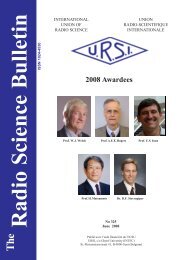Radio Science Bulletin 313 - June 2005 - URSI
Radio Science Bulletin 313 - June 2005 - URSI
Radio Science Bulletin 313 - June 2005 - URSI
- No tags were found...
You also want an ePaper? Increase the reach of your titles
YUMPU automatically turns print PDFs into web optimized ePapers that Google loves.
Editorial<strong>June</strong> in December?Yes, this is the <strong>June</strong> issue of the <strong>Radio</strong><strong>Science</strong> <strong>Bulletin</strong>, and it’s coming to you inDecember. This issue and the September andDecember issues of the <strong>Bulletin</strong> will be late, I’mafraid, and the responsibility is mine. I’m sorry.As one way of getting the <strong>Bulletin</strong> back onschedule, for the next few issues I will not bedoing the same level of editing on the materialwe publish as I have been.We have included in this issue material from the NewDelhi General Assembly, and all of the normal end-of-theyear listings of <strong>URSI</strong> radio scientists’ contact information,which would usually go into the December issue. Hopefully,we’ll be back on schedule by the spring.The XXVIIIth <strong>URSI</strong> GeneralAssemblyThe XXVIIIth General Assembly of <strong>URSI</strong> in NewDelhi, India, was a wonderful success. We had more than1400 attendees, and the quality of the technical sessions andposter presentations was outstanding. Equally outstandingwas the hospitality shown to all in attendance by our Indianhosts. As just one example, the banquet transformed thelawn and grounds of the National Physical Laboratory intoa wonderland of lights; food booths, with something forevery taste; wandering performers; handicraft booths; stageshows with puppets, live actors, acrobats, and dancers; anda pair of elephants giving rides at the entrance! Theinvolvement of the President of India in the openingceremony, presenting one of the General Lectures, andhosting a most elegant tea for the Young Scientists made thewhole experience of the General Assembly even morespecial. Heartfelt thanks go to Dr. A. P. Mitra, Dr. V.Kumar, Dr. P. Banerjee, Dr. M. K. Goel, and all of theircolleagues on the Local and National OrganizingCommittees, as well as their many colleagues at the NationalPhysical Laboratory, for the years of effort that made all ofthis possible. Special thanks, too, go to Prof. Gert Brussaard,the Coordinator for the Scientific Program, who led theorganization of the scientific program, and whose ability toadapt the organization to the changing needs of the GeneralAssembly as it was happening made the whole experienceso very excellent.The Council voted to hold the XXIXth <strong>URSI</strong> GeneralAssembly in Chicago, Illinois, August 9-16, 2008. Prof.George Uslenghi, incoming Chair of the US NationalCommittee for <strong>URSI</strong>, is the Chair of the OrganizingCommittee, and will be the AssociateCoordinator for the Scientific Program. Dr.M. K. Goel, of India, will be the Coordinatorfor the Scientific Program.Special Section HonoringCarl E. BaumThis issue and the March issue of the<strong>Radio</strong> <strong>Science</strong> <strong>Bulletin</strong> contain special sectionshonoring Carl E. Baum on his 65th birthday.We have two guest Editors for these special sections, JürgenNitsch and Frank Sabath, and they have provided an excellentintroduction to the special section, this time focusing onsome of the more personal aspects of Carl Baum and hiscontributions outside of science and engineering.What is “ultra-wideband?” This is the basic questionone of our Guest Editors, Frank Sabath, and his coauthors,E. L. Mokole, and S. N. Samaddar, address in their paper.Ultra-wideband signals and systems have come into widespreadusage in recent years. However, what constitutes an“ultra-wideband” signal or system varies from applicationto application, field to field, and even among emergingstandards. The authors identify and explain the majordefinitions and usage of the term, and also explain thedifferences among these. They then suggest some furtherresearch and discussion that could lead to a commondefinition and a classification scheme that could be widelyapplicable.Model-based parameter estimation is the process offitting a model to a set of data, and determining the parametersof the model that best fit the data. A very simple example isthe fitting of a polynomial curve to a two-dimensional plotof some data. The parameters involved are the coefficientsof the polynomial. In the case of trying to identify scatteringobjects from radar data, it can be very useful to fit a modelbased on a sum of complex exponentials. There are severalmethods of doing this, and a comparison of three of thesemethods is the topic of the paper by Seongman Jang,Wonsuk Choi, Tapan Sarkar, and Eric Mokole. Theyconsider the Matrix Pencil Method and two methods ofretrieving harmonics using a state-space approach. Theycompare the ability of these three methods to accuratelydetermine the poles of the models for five canonicalelectromagnetic scatterers. While the three methods performsimilarly when the data are smooth, they produce differentresults when the data are not smooth, and when there issignificant noise present. There are also significantdifferences in the computational requirements for the threemethods.The<strong>Radio</strong> <strong>Science</strong> <strong>Bulletin</strong> No <strong>313</strong> (<strong>June</strong>, <strong>2005</strong>) 3
















